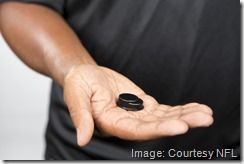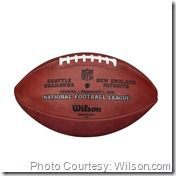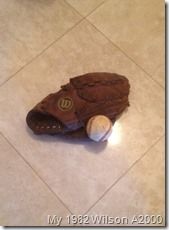nfl
5 TopicsThe Internet of Sports
Did you see what the NFL is doing this year with sensors? Earlier this month they announced a partnership with Zebra Technologies, a company that provides RFID chips for applications from 'automotive assembly lines to dairy cows' milk production.' This season there will be sensors in the player's shoulder pads which will track all their on field movements. This includes player acceleration rates, top speed, length of runs, and even the distance between a ball carrier and a defender. Next year they'll add sensors for breathing, temperature and heart rate. More stats than ever and could change the game for-ever. Imagine coaches being able to examine that data and instantly call a play based on it. Play by play. To me it somewhat takes away that 'feel' for the game flow but also having data to confirm or deny that feeling might make for exciting games. Maybe lots of 0-0 overtimes or a 70-0 blowout. Data vs. data. Oh how do I miss my old buzzing electric football game. The yardsticks will have chips along with the refs and all that data is picked up by 20 RFID receivers placed throughout the stadium. Those, in turn, are wired to a hub and server which processes the data. 25 times a second, data will be transmitted to the receivers and the quarter sized sensors use a typical watch battery. The data goes to the NFL 'cloud' and available in seconds. The only thing without a sensor is the ball. But that's probably coming soon since we already have the 94Fifty sensor basketball. And we've had the NASCAR RACEf/x for years and this year they are going to track every turn of the wrench with RFID tracking in the pits and sensors on the crew. Riddell has impact sensors in their helmets to analyze, transmit and alert if an impact exceeds a predetermined threshold. They can measure the force of a NBA dunk; they can recognize the pitcher’s grip and figure out the pitch; then the bat sensor that can measure impact to the ball, the barrel angle of their swings, and how fast their hands are moving; and they are tracking soccer player movement in Germany. Heck, many ordinary people wear sensor infused bracelets to track their activity. We've come a long way since John Madden sketched over a telestrator years ago and with 300 plus lb. players running around with sensors, this is truly Big Data. It also confirms my notion that the IoT should really be the Internet of Nouns - the players, the stadiums and the yardsticks. ps Related: Player-tracking system will let NFL fans go deeper than ever Fantasy footballers and coaches rejoice—NFL players to wear RFID tags More sensors are coming to professional sports, but research outpaces business models Why This Nascar Team Is Putting RFID Sensors On Every Person In The Pit Impact Sensors: Riddell InSite Impact Response System Fastpitch Softball League Adds Swing Sensors to its Gear Technorati Tags: rfid,sensors,IoT,things,nfl,cloud,big data,silva,f5 Connect with Peter: Connect with F5:527Views0likes1CommentIoT: Tabs to be Read Later
I've been traveling a bit over the last month and my tabs-to-read-later pile is growing. We'll be at AWS re:Invent next week so I thought I'd unload some of the IoT stories that caught my eye recently, that I'm finally getting to read. Apologies if this is old news to you. One I've been holding on to almost the longest is an interesting INC article Our Future Will be Analog, Not Digital. Geoffrey James talks about the Internet of Things and how people think the convenience of connectivity is more important than the risks involved. He talks about how snail mail, cash and unplugging are tending up along with how analog objects are becoming status symbols. This is a good one if you think all this connectivity will become so hackable and fragile that no one will want to use it. Next from The Economist, saying on the IoT theme, is Their own Devices. From Barbie's to cars to televisions, compromised computers are all over the place and few companies have the incentive to take security seriously within their widgets. There needs to be a change in corporate culture especially within non-computer companies. From the early days of the boiler explosions and crashes on railways to the safety of cars in the 70's to the hacks of medical devices today, we all need to recognize that connected devices need protection. And so do we. To that, from Mashable, is how Major automakers are forming an alliance to tackle cybersecurity.With the growing concerns and actual demonstrations of cars getting breached, the Alliance of Automobile Manufacturers and the Association of Global Automakers are forming an Information Sharing and Analysis Center, according to Automotive News. Chris Perkins says, the creation of the Information Sharing and Analysis Center (ISAC) represents an important proactive step from the industry to address these hacks before they happen. The last couple years during the NFL season, I've written some stories about technology in sports including Are You Ready For Some...Technology!! and more recently with Will Deflate-Gate Lead to Micro-Chipped Footballs? On Ars Technica, David Kravets goes deeper into the sensor technology being used by the NFL this year with How the NFL—not the NSA—is impacting data gathering well beyond the gridiron. He talks about how RFID is being used to track all the player's movements and how they will use the 2 to 3 gigs of data generated each game. Also how teams can use the data for training and coaching along with how console gaming might use it and how it could affect fantasy bets. Very interesting article on how all this connectivity plays into the games we watch, play and enjoy. OK, that's it for now and thanks for the chance to clean up some of my browser tabs. Now I got room for the next bunch. ps Technorati Tags: iot,sensors,things,digital,nfl,cars,security,silva Connect with Peter: Connect with F5:323Views0likes0CommentsWill Deflate-Gate Lead to Micro-Chipped Footballs?
Last summer I wrote about the some of the cool technology that the NFL was going to use during the 2014/15 season. There were sensors in the player's shoulder pads tracking all their on field movements. It measured player acceleration rates, top speed, length of runs, and even the distance between a ball carrier and a defender. Next year they'll add sensors for breathing, temperature and heart rate. More stats than ever and could change the game for-ever. The yardsticks had chips along with the refs and all that data was picked up by 20 RFID receivers placed throughout various stadiums. Those, in turn, were wired to a hub and server which processed the data. 25 times a second, data was transmitted to the receivers and that then went to the NFL 'cloud' and available in seconds. The only thing without a sensor was the football. Will that change now due to Deflate-Gate? No doubt if you are a NFL fan (or maybe not since it has dominated the news) you have heard of Deflate-gate. Apparently during the AFC Championship game, the New England Patriots' footballs were under inflated during the first half. With a pound of pressure missing, those footballs were slightly easier to grip and, in theory, supposedly gave New England an advantage. If not an advantage, just the simple fact that they were not inflated to the proper pressure per the rules. Personally, I really don't care as I'm a Miami Dolphins fan and anyone else in the AFC East (Jets, Bills, Patriots) can kiss my KISS tattoo. Deflate-gate has gotten so blown up that even science folks like Bill Nye the Science Guy and Neil deGrasse Tyson has gotten into the mix and of course, there is a SNL skit about it. But it got me thinking. If they had sensors or chips in/on the footballs, none of this would have occurred. The sensors would have alerted the officials that certain footballs were not at regulation air pressure - just like your car tires do with that dashboard indicator. If, somehow, the sensors didn't go off, they could have played back the football's GPS and movements leading up to the kickoff and this whole case would have been solved by the end of halftime. Imagine the replay booth, instead of showing the first half highlights, would be showing a layout of the stadium along with 24 little dots making their move from the locker room to the officials to the field and everything in between. I would bet that most of those All-Access passes people hang around their necks have some sort of chip that provides authenticity, you could add 'location' and then see all the people dots mingling with the football dots....and voila, who was near the equipment when this happened. As part of their internal investigation, the Patriots apparently re-created their entire pre-game routine to absolve themselves from any wrongdoing. Maybe next year they'll just pull up the 'Where's my Football' app during the post game press conference - 'See! My dot is here and the football dot is over there...I did nothing.' Go Hawks! ps Related The Internet of Sports Play Ball! Deflate-gate Is The Dumbest Sports Controversy Ever Bill Nye the Science Guy: Bill Belichick's Deflate-gate explanation made no sense Neil deGrasse Tyson: Science from Belichick, Patriots doesn't add up Video shows employee taking 24 balls into bathroom ‘SNL’ settles Deflate-Gate once and for all Technorati Tags: deflate gate,nfl,patriots,superbowl,sports,sensors,things,iot,football,f5,silva Connect with Peter: Connect with F5:359Views0likes1CommentPlay Ball!
...Oh Wait, Let Me Check the Stat-Cloud First! It is like a SAT question: Cincinnati Reds Billy Hamilton has a 10.83 foot lead off first base, can hit a top speed of 21.51 mph and clocked a jump of 0.49 seconds. If the Milwaukee Brewers catcher took 0.667 seconds to to get the ball out of his glove to throw to second and the ball is travelling at 78.81 mph, is Hamilton safe or out? A few weeks ago I wrote about the Internet of Sports, and can't believe I missed this one. But with the MLB playoffs in full gear, I didn't want this to slip through the IoT cracks. Sports analytics has been around for a while but never to this degree. Just like the NFL, Major League Baseball is equipping stadiums with technologies that can track moving players, flying baseballs and accurate throws. More than the RBIs, hits and stolen bases that appear on the back of trading cards, new technology (and software) also gathers stats like pop-fly pursuit range or average ground ball response time. Professional sports teams have always tracked their players' performance and often such milestones are included in the player's contract. Bonus for so many games played, or home runs hit or some other goal. With all this new detailed data, teams can adjust how they train, prepare for games and even player value for personnel moves like trades. For the 2014 season, only 3 stadiums (Mets, Brewers, Twins) had the new Field f/x (Sportvision Inc.) system but the league plans to have all 30 parks complete for the 2015 season. Field f/x can show data such as the angle of elevation of a batted ball, the highest point in its trajectory and the distance covered and top speed attained by a player attempting to field a ball. Of course all this can then be crunched for cool graphics during a replay. Cameras, sensors and software are all now part of the game. So are data centers, clouds and high speed links. All this data needs to be crunched somewhere and more often it is in a cloud environment. Add to that, the connection(s) to the fans and with the fans at the stadium. Levi's Stadium, for instance, has 1200 access points and an app that allows you to order food, watch instant replays and know which bathroom line is the shortest. Our sport stadiums are becoming data centers. Announcer: Welcome to Exclusive Sponsor Data Center Field! Home of the Hypertext Transfer Protocols. Undefeated at home this year, the Prots look to extend their record and secure home field throughout the playoffs. And if you were wondering, Hamilton was Safe. ps Related: New Baseball Season Brings Tech to Track Player Skills Major League Baseball brings new tech to the plate Baseball All-Stars’ Data Gets More Sophisticated With Field F/X The Internet of Sports Are You Ready For Some...Technology!! Is IoT Hype For Real? Technorati Tags: iot,things,baseball,sports,sensors,stats,big data,mlb,nfl,f5,silva Connect with Peter: Connect with F5:445Views0likes0CommentsAre You Ready For Some...Technology!!
Every year around this time football fans are drafting their fantasy leagues, wearing their favorite team's jerseys, stocking tailgate items and experiencing the new technologies that have become part of the game. From Second Screen apps to Catapult, technology is not only changing the game but also how fans experience the contest. As more fans engage with mobile devices, the TV broadcast is being regulated as the Second Screen. Usually the mobile device is used to access information that compliments the program but with NFL fans, particularly those who play fantasy leagues, it is the reverse. They are locked in to their mobile app, following multiple games, tracking stats, clicking on-demand videos and even watching teams not associated with their local market. The NFL sees a huge opportunity to reach and engage fans even more. Australia-based Catapult is being used by many NFL teams to track athlete performance among other metrics. A 3.5-ounce monitor situated between the player's shoulder blades monitors player movements within 15 centimeters and gives coaches acceleration, distance covered, speed, explosion times, exertion, hitting force and every other imaginable piece of data on a player's specific movements. It is changing the manner in which teams practice, recover from injuries and even plan for games. The San Francisco 49ers’ new Levi’s Stadium is touted as the most technologically advanced stadium in the league. With their stadium app, fans can check bathroom, food and beer lines along with streaming replays (with your choice of camera angle) and streaming NFL Redzone. There is plenty of WiFi capacity, which is actually uncommon at NFL stadiums. There is only a handful of teams with WiFi service in their football stadiums but Roger Goodell (NFL commissioner) wants to make wireless internet a standard in NFL stadiums in the coming years. There are many other advances like safer helmets with a chip that monitors the force of a hit, 2100-inch HDTVs, retractable grass and sustainable stadiums all making an impact. The best place to watch football is in the comfort of your own living room and teams are looking at ways of creating a living room atmosphere for 80,000 fans. And as you're waiting for tonight's kickoff, check out what this dad did for his kids. ps Related: NFL Tries to Capitalize on Rabid Fans Who See TV as the 'Second Screen' To the NFL, second-screen content isn't a team sport Second-screen audiences continue to grow Sports And Technology: How Catapult is revolutionizing the NFL The NFL's Technology Cornucopia The 49ers’ New Levi’s Stadium Is Going To Be The Most Technologically Advanced Building In Sports 5 Coolest New Technologies About to Tackle the NFL Top 5 Technologies in NFL Stadiums NFL lagging on stadium Wi-Fi Florida fan impressively turns his backyard into a football field CloudFucius Is: Ready for Some Football Technorati Tags: nfl,technology,sports,football,mobile,apps,stadiums,silva,catapult,f5,infrastructure,application delivery Connect with Peter: Connect with F5:285Views0likes0Comments



